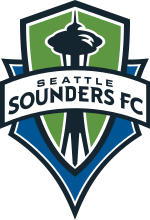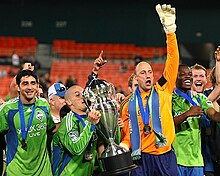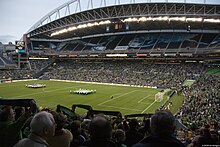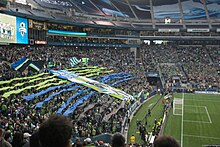Seattle Sounders FC
 | ||||
| Full name | Seattle Sounders FC | |||
|---|---|---|---|---|
| Nickname(s) | The Sounders, Rave Green | |||
| Founded | 2007 | |||
| Ground | Qwest Field Seattle, Washington | |||
| Capacity | 35,700 or 67,000 | |||
| Owner(s) | Joe Roth Adrian Hanauer Paul Allen Drew Carey | |||
| Head Coach | Sigi Schmid | |||
| League | Major League Soccer | |||
| 2009 | Western Conference: 3rd Overall: 4th Playoffs: Quarterfinals | |||
|
| ||||
Seattle Sounders FC is a Major League Soccer (MLS) team based in Seattle, Washington. It was established in November 2007 as an MLS expansion team. Fans chose the Sounders name through an online poll in 2008, making the Seattle Sounders FC the third Seattle soccer team to share the moniker.
The team's majority owner is Hollywood producer Joe Roth and its minority owners are Adrian Hanauer, Paul Allen, and Drew Carey. Two-time MLS Cup winner Sigi Schmid is the team's head coach. Sounders FC home matches are played at Qwest Field. Along with several organized groups, a 53-member marching band called the Sound Wave supports the team at each home game. Former BBC announcer Arlo White calls the play-by-play for local broadcasts. Seattle competes with rival club San Jose Earthquakes for the Heritage Cup.
Seattle Sounders FC, the league's 15th team, began play in the 2009 season. During their first season every home game was sold out, a new MLS record for average match attendance was set, and they sold the most season tickets in the league. The team finished the 2009 season with a winning record and qualified for the MLS playoffs where they were eliminated in the conference semi-finals. Sounders FC is the second expansion team in MLS history to win the U.S. Open Cup tournament in their first season.
History
Before the first cities in the US were chosen to host Major League Soccer teams, Seattle was considered a viable location for a professional team.[1] In 1994, as the US was preparing to host the FIFA World Cup, more than 30 cities were pursuing the rights to an MLS team, among them Seattle.[2] However, despite the strong soccer fan base in Seattle, the absence of a soccer-only stadium was a drawback to establishing an MLS team.[3] Cities seeking consideration for an inaugural MLS team were also expected to secure 10,000 assurances for season tickets.[2] By the June 3, 1994 deadline for MLS team bids, Seattle organizers had only secured a little over 1,300.[4] These low numbers were a result of competition between the ticket campaign for the MLS expansion team and for the American Professional Soccer League (APSL) Sounders expansion team.[5] In a June 14, 1994 announcement, Seattle was not included among the first seven cities to receive MLS teams.[1] Five more teams were to be announced later in the year and to improve their chances, Seattle MLS organizers began working with the University of Washington to secure use of Husky Stadium as an interim stadium while they pursued the construction of a permanent soccer-specific facility.[6] In November 1994 the start of the first MLS season was postponed from 1995 to 1996 and it was noted that the absence of an "adequate grass-field facility" in the area and the presence of the new APSL Seattle Sounders team had thwarted Seattle's MLS bid.[7] In the end, Seattle was not among the cities chosen to establish a team during the first season of the MLS.[8]
In 1996, as Seattle Seahawks owner Paul Allen worked with the city to build a new football stadium for his team, the potential of an MLS expansion team that could be a co-tenant helped drive public support for the effort.[9] Many of the state's voters supported the referendum to construct Seahawk Stadium because it was expected to be a professional soccer venue.[10] While the stadium problem was being resolved, a new issue emerged. By 2000, the MLS was moving away from league-operated teams to investor-operated teams, so wealthy individuals would need to step forward for Seattle to obtain an MLS expansion team.[10]
In 2002, Seattle was again listed as a possibility for an MLS expansion team when the ten-team league announced plans to expand into new markets.[11] In 2004, MLS commissioner Don Garber indicated that Seattle had been "very close" to receiving the expansion team awarded to Salt Lake. Adrian Hanauer, then-owner of the United Soccer League's (USL) Sounders (formerly the APSL Sounders), was in discussions with MLS about an estimated payment of $1 million to secure rights to a Seattle franchise for 2006.[12] When Seattle was passed over again during the 2006 season (the team went to Houston), Hanauer announced that he would not be able to secure an expansion team without the help of more investors willing to help cover the increasing MLS franchise fees which had grown beyond $10 million.[13]
MLS expansion arrives
In 2007, Hanauer worked with Hollywood producer Joe Roth to make another bid for MLS expansion into Seattle at a cost of $30 million.[14] Paul Allen, whose First and Goal company operated Qwest Field (formerly Seahawks Stadium), joined the ownership group that same year, making this bid the most promising yet.[15] During the first week of November 2007, rumors began to build that the MLS would be announcing an expansion into Seattle the following week and that the ownership group had taken on a fourth member: comedian Drew Carey.[16] In a press conference on November 13, 2007, it was announced that Seattle had been awarded an expansion team. The announcement provided a return of top-level soccer to Seattle for the first time since the dissolution of its North American Soccer League (NASL) team in 1983. The announcement also meant that the Seattle Sounders of the USL First Division would play their final season the year before the new MLS franchise was formed.[17][18]
Team name, badge and colors unveiled
"Seattle Sounders FC" was announced as the team name on April 7, 2008, along with the team logo, colors, and badge design, in a presentation held at the Space Needle.[19] The badge design resembles a heraldic shield and consists of two layers which represent "the partnership between the ownership, the community, the players and the fans".[20] The logo incorporates the Space Needle, an internationally recognized Seattle landmark. The official team colors are Sounder Blue, signifying the waters of the Puget Sound; Rave Green, representing the forests of the Pacific Northwest; and Cascade Shale, representing the Cascade Range to the east of Seattle.[20]
Fans chose a name for the team in an online poll held between March 27 and March 31, 2008. The initial list of possibilities—Seattle FC, Seattle Republic and Seattle Alliance—deliberately did not include Seattle Sounders in order to provide a "fresh start." Despite the names having been selected through fan research and internal committees, the omission of the traditional Sounders name was unpopular.[21][22] In response to fan feedback, the team added a fourth "write-in" option for the team name, allowing for any name to be suggested on the ballot.[23] Of the over 14,500 votes received for the new team name, 49% of the votes included some form of the name Sounders.[24] Upon announcing the name, Hanauer acknowledged the significance of keeping with tradition: "The team playing at the highest level in our region has always been called Sounders. Starting with the NASL and then the USL 1st Division, we now have the chance to create a separate and distinct identity with the new MLS team."[25]
Team ownership revealed the first Sounders FC jersey on May 28, 2008, and announced Microsoft as the team's sponsor in a five-year deal worth approximately $20 million.[26] As part of the agreement, the Xbox 360 and Xbox Live brands appear on the front of Sounders FC's jerseys and throughout the stadium.[27]
Inaugural season

Seattle Sounders FC, the league's 15th team, began play in the 2009 season. All 22,000 season ticket packages offered by the club for their inaugural season were sold,[28] giving them the most season ticket holders in the MLS.[29] They played their first home match on March 19, 2009, to a sold-out crowd of 32,523, defeating the New York Red Bulls 3–0.[30] Seattle was the first MLS expansion team to win their first three games, and they did so with a shutout in each.[31] The club set a state record for attendance at a soccer match on August 5, 2009, when 66,848 attended a friendly match with FC Barcelona.[32]
On September 2, 2009, Sounders FC became the second MLS expansion team in league history (Chicago was first) to win the U.S. Open Cup tournament in their first season.[33] They did so by defeating D.C. United 2–1 on the road at RFK Stadium.[34] In winning the U.S. Open Cup tournament, they qualified for the preliminary round of the 2010–11 CONCACAF Champions League.[33]
On October 17, 2009, Sounders FC became the second MLS expansion team in league history (again, Chicago had been first) to qualify for the playoffs in their first season. They clinched a playoff berth with a come-from-behind victory over the Kansas City Wizards 3–2 at Kansas City.[35] Seattle finished the regular season with a record of 12 wins, 7 losses, and 11 ties. The club set a new MLS record for average attendance at 30,943 fans per game.[36] Their inaugural season came to an end in the 2009 MLS Cup Playoffs when they lost in the conference semifinals to the Houston Dynamo with a 1–0 aggregate score in a two-legged series.[37] During the 2009 season, all 15 Sounders FC MLS regular season home matches, their home playoff match, and their 4 home U.S. Open Cup matches (played at Starfire Sports Complex) were sold out.[38]
Golden Scarf
During the pre-game ceremonies of the inaugural home match of the Sounders FC, a Golden Scarf emblazoned with the team name was awarded to MLS Commissioner Don Garber.[39] This began a tradition where, before each home game, the club likewise honors a member of the community who has contributed to soccer or society more generally in the Seattle area. The recipient and the fans then raise their scarves over their heads together. The presenter of the Golden Scarf, usually a representative of the club's owners, is also acknowledged as part of the ceremony.[40]
Stadium

Seattle Sounders FC plays home games at Qwest Field in Seattle, also home to the Seattle Seahawks.[41][42] The pitch was named "The Xbox Pitch at Qwest Field" as part of the sponsorship deal with Microsoft.[43] The team's training facilities and offices are located at the Starfire Sports Complex in nearby Tukwila.[44]
Qwest Field is a 67,000-seat stadium designed for both American football and soccer.[42] Sounders FC artificially limits the stadium's capacity for MLS games with certain seating sections covered with tarpaulins to provide "a more intimate atmosphere" and opens the entire stadium for international friendly matches.[41][45] Capacity for the stadium was originally limited to 24,500 before the start of the inaugural season.[41] However, due to high demand, capacity has been increased multiple times with it currently set at 35,700 for the 2010 season.[45][46][47]
While Seattle Sounders FC currently plays on FieldTurf, Qwest Field has previously had temporary natural grass installed for international soccer events.[48] If an MLS rule change requires natural grass playing surfaces, the field will be permanently replaced with natural grass.[49] For Seattle's international friendlies against Chelsea on July 18, 2009 and FC Barcelona on August 5, 2009, a temporary natural grass field was installed.[50]
Supporters

The Sounders FC Alliance was established at the request of minority owner Drew Carey. Based on the fan association at FC Barcelona, members of the Alliance have the ability to vote on the removal of the General Manager and on other team decisions. Season ticket holders become automatic members while non-season ticket holders may buy into the Alliance for a fee. Membership benefits include voting privileges, invitation to an annual meeting and other team perks. Members can also be elected to the Sounders FC Alliance Council by receiving at least 25 nominations from other members annually. The first vote on the General Manager is scheduled to be held in November of 2012 following Seattle's third season.[51] Drew Carey is the chairman of the Sounders FC Alliance.[52]
Carey also requested that Sounders FC have their own marching band. They are the first franchise in the MLS to have one.[53] This led to the creation of the Sound Wave, a 53-member marching band consisting of brass and marching percussion.[54] The band plays music from multiple genres such as Latin, rock and pop,[54] and sits with the supporters in the north end of Qwest Field.[55] The March to the Match, in which fans march from Occidental Park to Qwest before each home game, is led by the Sound Wave.[56]
Besides the Alliance, there are currently five recognized, independent supporters groups for Sounders FC. Emerald City Supporters (ECS), which formed in 2005 to support the USL Sounders, is the largest supporter group and sits in the south end of the stadium in sections 121–123.[57] SoCal Sound is an off-shoot of ECS based in Southern California, that attends Sounders games played at The Home Depot Center in Carson, California.[58] Gorilla FC is a Sounders FC supporters group that sits in the south end of Qwest Field in Sections 120 and 119.[59] The North End Supporters sit in the north end of the stadium beneath the "Hawks Nest" in sections 100 and 144–152.[60] Immortal Fury, formed in the fashion of South American torcidas, focuses on bringing color to the south end of the stadium by displaying the national flags of several countries.[61]
Rivalries
The Seattle–Portland and Seattle–Vancouver rivalries formed in the years that the NASL-Sounders and USL-Sounders were playing in Seattle. These geographic rivalries are expected to continue when the MLS awards teams to both Portland and Vancouver for the 2011 season.[62] In 2004 the fan-based Cascadia Cup was created to formalize the competition between the Seattle, Portland, and Vancouver USL teams.[63]
The fan-created Heritage Cup competition with the San Jose Earthquakes was begun in the 2009 MLS season. MLS teams that carry on the names of their NASL predecessors are eligible to compete. The results of their league matches determine the winner.[64]
Ownership and team management
The team ownership group is composed of four investors. The majority owner is Hollywood producer Joe Roth, with minority owners Adrian Hanauer, former owner of the now defunct USL-1 team Seattle Sounders; Paul Allen, Microsoft co-founder and owner of the Seattle Seahawks and Portland Trail Blazers; and Drew Carey, comedian and game show host.[65]
Sounders FC officially introduced Sigi Schmid as their first coach on December 16, 2008.[66] Schmid had previously led the Los Angeles Galaxy to a MLS Cup in 2002 and the Columbus Crew to a MLS Cup in 2008. Brian Schmetzer is the top assistant coach[67] and Tom Dutra is the goalkeeper coach.[68] Retired MLS veteran defender Ezra Hendrickson joined the Sounders as an assistant coach in January 2009.[69] Former MLS player and Everett, Washington native Chris Henderson was named technical director on January 24, 2009.[70] Longtime Seattle Seahawks executive Gary Wright is the senior vice president of business operations.[71]
Broadcasting
Seattle Sounders FC matches are televised in English by either KING-TV or KONG-TV, except those nationally telecast matches on Fox Soccer Channel or ESPN2/ABC. Former Seattle SuperSonics announcer Kevin Calabro and former U.S. soccer star Greg Vanney called the play-by-play for the local broadcasts during the inaugural season in 2009.[72][73] However, they were replaced by former BBC announcer Arlo White for the 2010 season, who calls both the English language radio and television broadcasts without a partner.[74] Matches are televised in Spanish on THIS-TV with Jaime Mendez and Hugo Alcaraz-Cuellar calling the action. On radio, Sounders FC matches are aired in English on KIRO-FM and in Spanish on Ke Buena AM.[75]
A weekly wrap up show for Sounders FC and MLS news known as Sounders FC Weekly began airing March 22, 2009.[76] The show airs Sunday evenings on KONG-TV.[77]
Honors
- Lamar Hunt U.S. Open Cup
- Winners: 2009
Players
Current roster
As of May 1, 2010.[78]
Note: Flags indicate national team as defined under FIFA eligibility rules. Players may hold more than one non-FIFA nationality.
|
|
